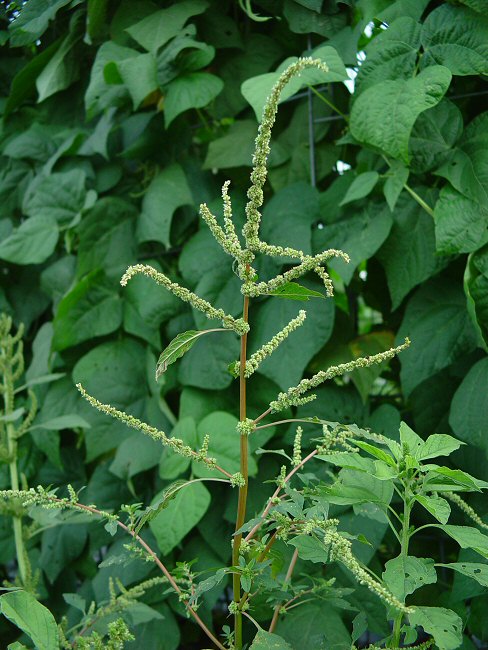Amaranthus spinosus L.
Spiny Pigweed

Introduced
CC = *
CW = 3
MOC = 42
© DETenaglia
Amaranthus spinosus L.Spiny Pigweed | |
 |
Introduced CC = * CW = 3 MOC = 42 |
© DETenaglia |
|
Family - Amaranthaceae Habit - Annual monoecious forb. Stems - Ascending to erect, to 1.5 m, mostly glabrous, with conspicuous pairs of spines at most nodes.
Leaves - Mostly long-petiolate, with blades 2-10 cm long, narrowly ovate to ovate, bluntly or sharply pointed, narrowed or tapered at the base, glabrous or nearly so.
Inflorescences - Dull or grayish green, occasionally reddish-tinged; axillary and terminal; the axillary inflorescences dense, small, globose clusters or elongate spikes; the terminal inflorescence a spike or panicle with few ascending branches; the flowers often grouped into discontinuous clusters or regions along the basal portions of the spikes; the tip straight or somewhat curved at maturity; the main axis and branches glabrous or nearly so. Bracts 0.5-1.0 mm long, shorter than the sepals, lanceolate to linear, narrowed or tapered to a sharply pointed tip, with a thickened green midrib and relatively narrow, thin, papery margins, the midrib not or only slightly extending beyond the main body as a minute, sharp point.
Flowers - Staminate flowers with 5 sepals, these 1.0-1.6 mm long, somewhat outward-curved, oblong-lanceolate, sharply pointed. Pistillate flowers with 5 sepals, these 1.0-1.6 mm long, otherwise similar to sepals of staminate flowers. Stamens 5. Stigmas 3, ascending to erect. Ovule 1.
Fruits - Fruits 1.5-2.0 mm long, dehiscing irregularly, the surface somewhat roughened or wrinkled above the midpoint when dry. Seeds 0.7-1.0 mm in diameter, rounded along the rim, the surface black, shiny. Flowering - June - October. Habitat - Waste ground, cultivated fields, disturbed sites, roadsides, railroads. Origin - Native to tropical America. Lookalikes - Many other species of Amaranthus and Chenopodium. Other info. - This introduced weed can be found throughout Missouri and can be quite common in the habitats mentioned above. In general, plants in the genus Amaranthus are difficult to identify to species, but this one is an exception to the rule. The stout spines at the nodes are diagnostic, and they make this plant nasty to deal with. Photographs taken off Main St., Ellington, MO., 7-18-04 (DETenaglia); also at the Whiskey Creek Sheep Farm, near Krakow, Franklin County, MO, 6-16-2021 (SRTurner). |